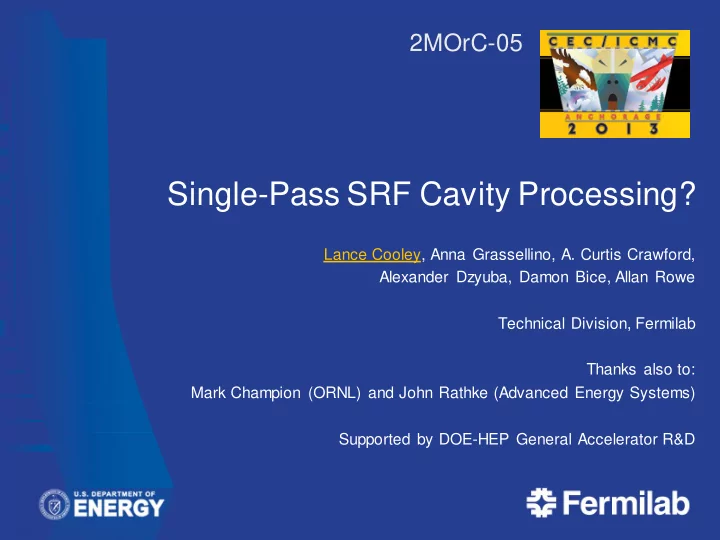

2MOrC-05 Single-Pass SRF Cavity Processing? Lance Cooley, Anna Grassellino, A. Curtis Crawford, Alexander Dzyuba, Damon Bice, Allan Rowe Technical Division, Fermilab Thanks also to: Mark Champion (ORNL) and John Rathke (Advanced Energy Systems) Supported by DOE-HEP General Accelerator R&D
Important points to take away • Excellent Q and gradient were obtained for only a single polishing step and without 600-800 °C vacuum annealing Key step: Half cells were annealed as a batch prior to welding or chemical polishing When Q-disease was encountered, a vacuum anneal (see Grassellino talk) was effective without need for a subsequent chemical polish • Materials R&D may explain why A threshold of cold work + polishing time defines a point where hydrogen absorption becomes accelerated Annealed metal is below this threshold – NO de-gassing • Proposal: weld anneal light EP A very simple, low-cost cavity process? Materials R&D should tweak the anneal to balance strength, recovery of “damage”, and EP requirement 2 Lance Cooley et al., CEC-ICMC 2013, 2MOrC-05
Flashback to 2011 • “Annealing to mitigate pitting in SRF cavities” Selected for best structural materials paper! • Lesson: annealing helps to reduce pits, but does not eliminate them entirely HAZ HAZ Weld Weld CW + weld + 12 hrs @ 600 °C CW + weld + 2 hrs @ 800 °C 1 cm x 1 cm 1 cm x 1 cm 3 Lance Cooley et al., CEC-ICMC 2013, 2MOrC-05
Verification of dislocation clustering? EP + 800°C 3h A B ½ cell A B cut-out C D F E C D After 100 µm EP Sample E 2.8 mm (all pix) E F RF side (all pictures) A. Dzyuba 4 Lance Cooley et al., CEC-ICMC 2013, 2MOrC-05
Cavity fabrication details • 10 single-cell cavities were commissioned from AES in August 2011 1 cavity was large grain material • Special treatment: After deep-drawing half cells, AES shipped them to Fermilab for annealing in our cavity furnace used for de-gassing A titanium alloy rack was constructed to support the half cells Batch heat treatment, 800 °C, 2 hours Cleaning procedures were applied before annealing • The annealed half cells were welded and finished cavities delivered to Fermilab in 2012 Pre-weld typically requires a 25 µm etch, done at 12 °C 5 Lance Cooley et al., CEC-ICMC 2013, 2MOrC-05
Vertical Test after BULK EP ONLY • NO VACUUM ANNEAL; yes - 120°C / 48 hr vac. bake 1 E+11 TE1AES012 TE1AES013 TE1AES014 Quality Factor 1 E+10 Q-disease test passed for #12, #14 Q-disease test failed for #13, Fixed after standard de-gassing anneal (data shown here) 1 E+09 0 5 10 15 20 25 30 35 40 45 50 Accelerating Gradient, MV/m 6 Lance Cooley et al., CEC-ICMC 2013, 2MOrC-05
Meanwhile… Study of hydrogen uptake • Experiment: Annealed niobium bars were strained in our tensile tester, 12%, 27%, 35%, and 50% elongation • Control and strained bars were electropolished, 50 to 250 µm material removed Standard temperature, voltage, etc. – see our earlier coupon EP literature • Resistivity measurements were used to infer hydrogen content R (11K) was especially sensitive to hydrogen uptake, on top of the contribution from cold work. Vacuum annealing at 800 °C for 2 hours degassed much hydrogen as well as recovered cold work Resistance jumps were observed as temperature was swept through the range associated with hydride precipitate formation Jumps were absent after the vacuum anneal 7 Lance Cooley et al., CEC-ICMC 2013, 2MOrC-05
Resistivity at 11 K after strain + EP 8 Lance Cooley et al., CEC-ICMC 2013, 2MOrC-05
Strain – EP – Hydrogen absorption surface Threshold for accelerated hydrogen uptake Annealed pieces resist hydrogen uptake Isagawa 1980 J. Appl. Phys . 51 , 4166 9 Lance Cooley et al., CEC-ICMC 2013, 2MOrC-05
Resistivity reveals hydride formation 10 Lance Cooley et al., CEC-ICMC 2013, 2MOrC-05
Conclusion – Anneal first, EP only once • i.e. INVERT the standard sequence… • The success of the annealed single-cell cavity experiments is explained by the material R&D study Annealed niobium does not take up hydrogen as quickly as cold-worked niobium EP was also conducted with external water cooling Evidently, annealing to mitigate pitting also is annealing to mitigate hydrogen uptake – No need for post EP de-gassing • Annealing should reduce the material “damage layer” “Damage layer” consists of various structural and chemical defects that are introduced by rolling, forming, machining We have never found clear evidence for this layer Many past cavity results show improved properties with increased material removal How much chemical polishing is then needed if the annealing produces a full recrystallization? Will a “light EP” suffice? 11 Lance Cooley et al., CEC-ICMC 2013, 2MOrC-05
Recommend
More recommend